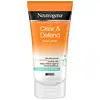Simple Skincare Protect ‘n’ Glow Detox & Brighten Clay Mask Versus Neutrogena Clear & Defend Facial Scrub
What's inside
What's inside
 Key Ingredients
Key Ingredients

 Benefits
Benefits

 Concerns
Concerns

 Ingredients Side-by-side
Ingredients Side-by-side

Water
Skin ConditioningSodium C14-16 Olefin Sulfonate
CleansingCocamidopropyl Hydroxysultaine
CleansingSorbitol
HumectantCellulose
AbsorbentSalicylic Acid
MaskingSodium Hydrolyzed Potato Starch Dodecenylsuccinate
Acrylates Crosspolymer-4
Emulsion StabilisingC12-15 Alkyl Lactate
EmollientPanthenol
Skin ConditioningCocamidopropyl Pg-Dimonium Chloride Phosphate
Talc
AbrasiveDisodium Tetrapropenyl Succinate
Cera Microcristallina
Emulsion StabilisingSodium Chloride
MaskingDisodium EDTA
Citric Acid
BufferingSodium Hydroxide
BufferingBenzalkonium Chloride
AntimicrobialParfum
MaskingCI 19140
Cosmetic ColorantCI 73360
Cosmetic ColorantWater, Sodium C14-16 Olefin Sulfonate, Cocamidopropyl Hydroxysultaine, Sorbitol, Cellulose, Salicylic Acid, Sodium Hydrolyzed Potato Starch Dodecenylsuccinate, Acrylates Crosspolymer-4, C12-15 Alkyl Lactate, Panthenol, Cocamidopropyl Pg-Dimonium Chloride Phosphate, Talc, Disodium Tetrapropenyl Succinate, Cera Microcristallina, Sodium Chloride, Disodium EDTA, Citric Acid, Sodium Hydroxide, Benzalkonium Chloride, Parfum, CI 19140, CI 73360
 Reviews
Reviews

Ingredients Explained
These ingredients are found in both products.
Ingredients higher up in an ingredient list are typically present in a larger amount.
Citric Acid is an alpha hydroxy acid (AHA) naturally found in citrus fruits like oranges, lemons, and limes.
Like other AHAs, citric acid can exfoliate skin by breaking down the bonds that hold dead skin cells together. This helps reveal smoother and brighter skin underneath.
However, this exfoliating effect only happens at high concentrations (20%) which can be hard to find in cosmetic products.
Due to this, citric acid is usually included in small amounts as a pH adjuster. This helps keep products slightly more acidic and compatible with skin's natural pH.
In skincare formulas, citric acid can:
While it can provide some skin benefits, research shows lactic acid and glycolic acid are generally more effective and less irritating exfoliants.
Most citric acid used in skincare today is made by fermenting sugars (usually from molasses). This synthetic version is identical to the natural citrus form but easier to stabilize and use in formulations.
Read more about some other popular AHA's here:
Learn more about Citric AcidWater. It's the most common cosmetic ingredient of all. You'll usually see it at the top of ingredient lists, meaning that it makes up the largest part of the product.
So why is it so popular? Water most often acts as a solvent - this means that it helps dissolve other ingredients into the formulation.
You'll also recognize water as that liquid we all need to stay alive. If you see this, drink a glass of water. Stay hydrated!
Learn more about Water